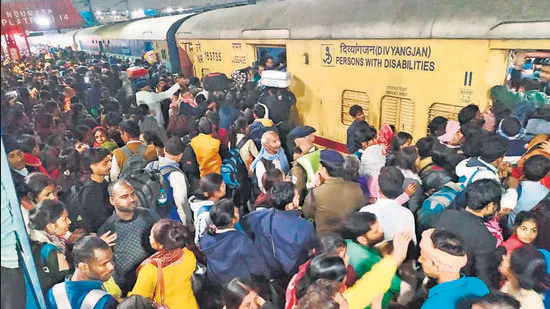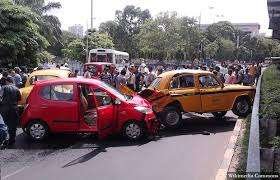
New Delhi Railway Station Stampede Kills 18 Maha Kumbh Rush
Tragedy Strikes at New Delhi Railway Station
A devastating stampede at New Delhi Railway Station late Saturday night claimed 18 lives, including 14 women. Several others sustained critical injuries, prompting an urgent emergency response. The chaos unfolded on platforms 14 and 15, where thousands of passengers gathered to board trains bound for Prayagraj amid the Maha Kumbh festival rush.
Overcrowding escalated tensions, creating a panic-driven surge as desperate travelers rushed toward incoming trains. In moments, confusion turned into catastrophe. Passengers fell, cries for help echoed, and the sheer force of the crowd made movement impossible. Security personnel struggled to restore order, but the damage had already been done.
What Caused the Deadly Stampede?
Uncontrolled Crowd Pressure
The massive influx of passengers played a crucial role in triggering the incident. With thousands seeking to reach Prayagraj for Maha Kumbh, railway platforms became dangerously congested. The lack of effective crowd control measures only worsened the situation.
Poor Security Arrangements
Despite expectations of large crowds, authorities failed to deploy adequate security personnel. The absence of barricades, organized queues, and trained marshals allowed unregulated movement, ultimately leading to chaos.
Train Delays Increased Panic
Adding to the disorder, prolonged train delays heightened frustration. As multiple trains arrived simultaneously, a sudden rush to board escalated into a stampede-like situation.
Misinformation and Lack of Clear Announcements
Confusion surrounding train arrivals and departures left passengers scrambling for clarity. Inconsistent announcements misdirected many, forcing them to run between platforms, further fueling panic.
Eyewitness Accounts: Moments of Horror
Survivors Share Their Experiences
🚆 Ramesh Yadav, a commuter from Uttar Pradesh, described the terrifying moment:
“I was near the train doors when a sudden push came from behind. People started falling over each other, and I barely escaped by grabbing onto a railing.”
🚆 Sunita Devi, who tragically lost her sister, said:
“We were holding hands tightly, but when the crowd surged, we got separated. I searched for her everywhere, but it was too late.”
🚆 Rajiv Sharma, another witness, blamed security lapses:
“There was no proper crowd management. Everyone was climbing over each other, desperately trying to move forward. It was pure chaos.”
Casualties and Rescue Efforts
Death Toll and Medical Response
🚑 18 confirmed fatalities, including 14 women.
🚑 More than 40 injured, some in critical condition.
🚑 Immediate transport of victims to nearby hospitals.
Authorities have announced compensation for affected families, while hospitals struggle to manage the sudden surge of patients needing urgent care.
Government and Railway Authorities Respond
Prime Minister Modi Expresses Condolences
Prime Minister Narendra Modi expressed deep sorrow over the tragedy. In a statement, he assured affected families of government support and promised strict action to prevent future disasters.
Railway Minister Orders High-Level Investigation
Railway Minister Ashwini Vaishnaw directed an immediate probe into the incident. Officials are evaluating safety lapses and crowd management failures to implement corrective measures.
New Safety Measures Announced
🚆 Increased deployment of security personnel at crowded stations.
🚆 Real-time monitoring through CCTV surveillance.
🚆 Revised train scheduling to prevent congestion.
🚆 Mandatory pre-ticketed access to platforms for better crowd control.
Maha Kumbh’s Impact on Railway Overcrowding
The Maha Kumbh Mela is recognized as the largest religious gathering in the world, drawing millions of devotees to Prayagraj.
Why Was the Station Overcrowded?
🔥 Excessive travel demand: More passengers than available train capacity.
🔥 Inefficient crowd management: No clear strategies in place.
🔥 Lack of pre-planning: Many passengers arrived without reservations, leading to disorganization.
Past Incidents: History Repeats Itself
🚨 2013: Allahabad Railway Station stampede during Kumbh Mela killed 36 people.
🚨 2011: Temple stampede in Kerala led to over 100 fatalities.
These tragedies emphasize the need for proactive safety measures to avoid repeated loss of lives.
How Can Future Stampedes Be Prevented?
Better Crowd Management Strategies
✔️ More trained personnel at high-risk stations.
✔️ Separate entry and exit points to regulate movement.
✔️ Pre-booked tickets only to manage passenger flow.
Improved Communication Systems
✔️ Clear and frequent train announcements.
✔️ Digital display boards with real-time updates.
✔️ Dedicated helplines for passenger assistance.
Enhanced Emergency Preparedness
✔️ Medical teams stationed at key platforms.
✔️ Rapid evacuation procedures in place.
✔️ Simulated drills for railway staff to handle crisis situations.
Conclusion: A Preventable Disaster
The New Delhi Railway Station stampede underscores the urgent need for better crowd control. With 18 lives lost and many others injured, authorities must act swiftly to prevent similar tragedies.
Key Takeaways:
✅ Stronger crowd regulation policies are essential.
✅ Security personnel require proper training and resources.
✅ Passengers need clear and timely communication.
As India continues to witness large-scale religious and cultural gatherings, it is crucial to implement strict safety measures to safeguard public lives.
Final Thoughts
The New Delhi Railway Station stampede has left families grieving and raised serious concerns about railway safety. As investigations unfold, authorities must take decisive steps to ensure passengers are protected from future mishaps.
Stay updated for further news on railway safety and government actions!









Add comment